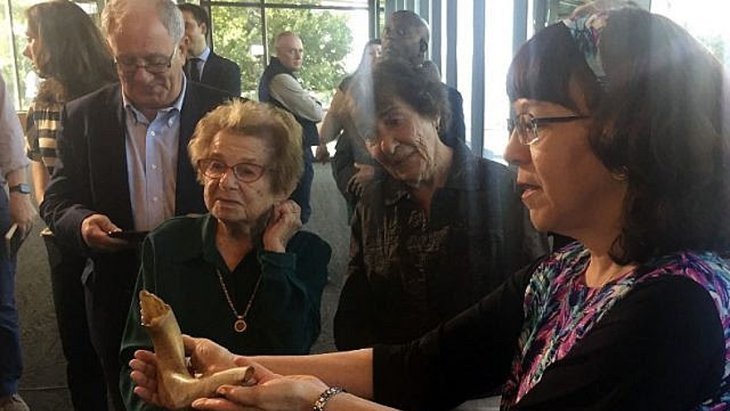 We Were the Lucky Ones
We Were the Lucky Ones


6 min read
In a Nazi labor camp, Jewish prisoners blew the shofar on Rosh Hashanah.
Rosh Hashanah, 1944: A group of ragged Jewish prisoners assembled for yet another exhausting work detail. All around, Jews were starved, tortured and murdered. The slightest expression of Jewish faith was strictly forbidden, grounds for execution by Nazi guards.
Yet on that Rosh Hashanah, a group of courageous Jews managed to pray with a minyan. Miraculously, they even managed to blow a shofar and evade detection. Prof. Judy Tydor Schwartz, the Director of Holocaust research at Bar Ilan University in Israel, is the daughter of the man who facilitated that astounding feat. In an Aish.com exclusive interview, she described her remarkable father, Chaskel Tydor, and his shofar.
When World War II broke out, Chaskel was 36 and living in Frankfurt with his wife Bertha and young children. They managed to send a son and daughter to relative safety in Belgium on the Kindertransport, a scheme that allowed Jewish children to escape Nazi Germany in 1939. Later that year Chaskel was arrested and sent to Buchenwald concentration camp; in 1942 he was sent to a forced labor camp near Auschwitz. There, he learned that Bertha and other relatives had been murdered in Auschwitz.
Though he briefly succumbed to despair, Chaskel soon found meaning in helping others. “He had done all he could to save lives and help as many as he could retain their spirits and religious beliefs,” Prof. Tydor Schwartz said. “He sent friends mishloach manot (gifts of food) on Purim when it meant he went without food to do so. He secretly lit Chanukah candles. He taught Pirkei Avot (Ethics of the Fathers) secretly in Buchenwald and later in Auschwitz.”
Chaskel was named block secretary and work arranging labor details for his fellow Jews. He used that position to help others, sending groups of prisoners to far away sites where they could pray together as a group. On Rosh Hashanah in 1944, he scheduled a group of over ten Jewish prisoners to work in a remote location. It was understood that they would pray at least part of the Rosh Hashanah service.
When the men returned, they told Chaskel an astonishing secret: one of them had managed to smuggle a shofar into their work detail and they’d listened to its blasts. The thought that Jews had managed to fulfill the mitzvah of blowing a shofar, which is meant to rouse us out of spiritual slumber with its piercing sound, seemed to almost defy belief. Yet the men had done it, hearing the Rosh Hashanah shofar in the very shadow of Auschwitz’s crematoria.
Prof. Tydor Schwartz speculates that the shofar might have been smuggled into the camp after mid-1944, when 440,000 Hungarian Jews were deported to Auschwitz. Their belongings were warehoused in a vast area known by the nickname “Canada” and some Jewish prisoners succeeded in smuggling objects from there into Auschwitz.
In her research, Prof. Tydor Schwartz has come across many other stories of Jews defying Nazi guards and performing Jewish mitzvot and prayers during the Holocaust. “The mother of one of my dearest friends is a religious survivor of Auschwitz in her mid-90s. She and her sister worked in the ‘Canada’ storehouse barracks and would try to smuggle out things, including religious artifacts, to the camp. My father and friends of his told me of the shofar and a pair of tefillin in Auschwitz.” Prof. Tydor Schwartz has also gathered first-person accounts of Jews constructing a makeshift sukkah secretly in Auschwitz, made out of an empty barrel.
“Of course if caught, they would have been killed,” she said. “Even to stand and daven (pray) for a moment was dangerous.”
In the beginning of 1945, with Allied troops advancing, the Nazis began blowing up the Auschwitz death camp and satellite labor camps. Chaskel Tydor and about 60,000 other Jewish prisoners were sent on a death march to another camp thirty miles away. The night before they left, a fellow prisoner came up to him and handed him a bundle wrapped in dirty rags: the precious shofar they’d sounded on Rosh Hashanah.
The man told Chaskel that he didn’t think he’d survive the march, so he wanted Chaskel to take it. If Chaskel survived, the man instructed, he should tell the world that Jews blew the shofar in Auschwitz.
Chaskel survived the war and moved to the land of Israel, then under British rule. As his ship approached the coast of Haifa on Rosh Hashanah in 1945, Chaskel blew the Auschwitz shofar once again, celebrating the Jewish New Year within sight of the Israeli city of Haifa.
In later years, Chaskel worked in America, where he met his wife Shirley Kraus and where his daughter Prof. Tydor Schwartz was born. He worked in New York, Montana and South Dakota, and eventually moved back to Israel. Everywhere he went, he took his precious shofar.
“My father would blow the shofar at home for those who could not go to shul to hear it – women with small children, ill, elderly. He would blow it for my grandmother when she was unable to walk to shul, for me when I gave birth, and for all the women in our building with small children who could not go to shul,” Dr. Tydor Schwartz recounted.
"My father was extremely courageous and had a strong belief in God. He always tried to help as many as he could, even at great personal cost. He was a tremendous mensch and so much more. He may have been five foot two, but he was a giant of a man.”
On September 23, 2019, her father’s precious Auschwitz shofar came to America where it will be displayed in the Museum of Jewish Heritage in New York. But first it will be blown in some New York City synagogues on Rosh Hashanah, letting Jews once again hear the sounds that helped sustain Jewish prisoners in Auschwitz a generation ago.
She hopes his legacy and the story of the shofar gives people hope and conveys the message that "we all have to look inside ourselves to find the inner strength to do good in this world, under all circumstances and conditions.”
